Knife Defence is one of the most controversial subjects in Martial Arts and Self-Defense.
Well, in this guide, we are going to tackle the subject and dispel any myths.
By drawing on a study of over 250 knife attack incidents, you are going to learn everything you need to know about training to defend yourself from a person with a knife.
Ready?
Let's dive in.
We Studied Over 250 Knife Defense Incidents And These Were The Core 6 Learning Points
Recently, we decided to conduct a study on Knife attacks.
We studied and broke down over 250 incidents to uncover the truth on the subject.
Part of the reason we did this study was that I felt that existing studies were done based on 'confirmation bias'.
These were self-defence instructors looking for data to support their particular style of Martial Arts or belief system.
For example, a previous study stated that 70% of offenders lead with a free hand grabbing or touching the victim before the attack.
This was not seen in our more extensive data set.
So, what were our core 6 takeaways?
Context Matters In Knife Defence
Knife defence tends to be taught with a 'one size fits all' approach.
And the vast majority of knife defense techniques are taught as if the offender is in front of the victim.
This simply wasn't the reality.
Nor was the data around a leading hand or grabbing hand being used to take hold of the victim.
In fact, this technique was only seen where the victim either knew the offender or was engaged in dispute before the attack, and therefore the offender was in front of the victim.
The reality is that the context, i.e. the victim's profession, the location and motive behind the attack mattered to the type of attack used.
Civilian Victims Were Mostly Attacked From Behind Or The Side
As stated, the vast majority of knife defense is taught as if the offender is in front of the victim; this isn't the case for civilians.
In fact, offenders attacked most victims from behind or the side.
The counter-argument to this is that the victims need to possess better awareness.
Yet, this wasn't supported by the study.
Offenders Often Attacked Victims With Little or No Warning and While in Routine Situations
From sitting on a bus to walking to work in a residential street, and even a woman sat at her office desk.
Awareness is often deemed the 'ultimate' self-defense technique, yet offenders seemed to avoid showing any pre-contact indicators tactically.
In other words, they disguised their intentions, leaving victims with no chance to defend themselves.
Victims Defend Themselves While Seriously Injured
The third key takeaway for victims of knife defence is that most have been stabbed before they could defend themselves.
This places a new emphasis on the realities of knife defence.
Because for most people, you will start with a severe or potentially life-threatening injury and HAVE to defend yourselves.
This information means that for most people, their ability to defend themselves will reduce as the duration of a knife attack increases.
Speed in defence and rendering the attacker incapable of attacking are therefore crucial aspects to be investigated.
Law Enforcement and Other Public-Facing Roles Are Likely To Face Attacks From The Front
From shop workers to police officers, the majority of attacks of this nature are via the front.
Also, this is worsened because store workers are often behind enclosed spaces that are difficult to escape from and causes them to be pinned down.
The Victim Has No Idea The Offender Has A Knife
The very basis of most knife defence systems is that you KNOW the offender had a weapon.
It is visible and openly held.
Yet our data suggest that only around half of all incidents occurred where the offender has displayed the weapon.
This causes issues for realistic defensive training, as techniques must work with zero reaction time.
A Data-Driven Solution For Knife Defense
Given the first study looked at a range of factors such as context, incident duration, knife concealment, location of attack, motive and the ambush/ surprise attack element.
We decided that if we were to give a data-driven guide on knife defence honestly, we needed to dive deeper.
As such we commission a second survey of the original 250 attack videos.
This time we looked at other aspects.
These were:
Number of offenders
Body area attacked
Controlled attack or frenzied
Type of grip used to hold the weapon
When combined with our original study, this provides a wealth of information to draw from.
This will allow us to address the subject of knife defense with the reality it deserves.
Can You Survive A Knife Attack?
The first and most obvious question we need to answer is 'can you survive a knife attack'?
Knives or other sharp objects were involved in 46 % of homicides in England and Wales in 2018/19, the most of any killing method.
And there were over 44,076 offences in 2018/2019 involving a knife or sharp object.
However, we know that there were only 650 Homicides in England and Wales during this time.
This means that roughly only 299 fatalities occurred out of the 44,076 knife or sharp object offences.
While other countries may be different, it is fair to say that most recorded knife-related crimes are entirely survivable.
But this does make sense.
People use knives to commit crime, mostly street robberies, and if the victim does as the offender wishes, i.e. give them their belongings, there is little extra to be gained by committing a murder.
So, what's the learning point here?
Well, training self-defence students to fight back against a street robbery is pretty stupid.
This is evidenced by the fact that knives and sharp objects accounted for the number one killing method in England and Wales.
So, if they have a knife, doing, as they say, is, without doubt, a core tactic for survival.
How fast is a knife attack?
Most knife attacks last between 10 and 60 seconds.
However, that is only part of the story.
Our study looked at the duration of 250 knife defence incidents.
Again, previous studies only look at their data as a whole picture without looking at the attack context.
The result is that the circumstances of the attack makes a huge difference to the time it takes.
For example.
Our data shows that any robbery involving knives is likely to last over 60 seconds if you work at a convenience store.
Yet a street robbery with an edged weapon is only likely to last between 10 and 20 seconds.
And disputes generally lasted between 10 and 40 seconds, with law enforcement attacks lasting over 60 seconds.
Quite shockingly, previous studies into this area have stated:
"If you can hold your ground for 7 seconds during an attack, the aggressor is more likely to give up."
This data and statement are not only a reckless but also false.
There can be no inference that trying to defend yourself for 7 seconds will increase your likelihood of survival.
And it is mostly the circumstance of the incident that dictates the speed of the attack,
For example, convenience store robberies generally last longer due to the cashier's desk being between the offender and the victim, creating a natural barrier to the attack.
And the offender is looking for money, has to try and take that money, all while dealing with the cashier who may or may not be trying to fight back.
As a result of this data, it is dangerous and verging on instructor incompetence to tell/ teach people that to survive they just need to hold on for 7 seconds or longer.
Attacks last as long as they last, and in general expect them to last for at least 60 seconds.
How Many People Are Likely To Attack You With A Knife?
In our data, we discovered that a single attacker commits over 76% of knife attacks.
Therefore, regardless of numbers in a gang or group that attack you, only one person will stab you.
So, what can we draw from this data?
Well, if attacked by a group, we need to consider that one of them has a blade and could use it.
And realistically we would not have to fight 2 or more people with a blade.
While this can not be a given, it needs to be considered by the self-defence industry with regards to defensive tactics.
You might be asking why only one person from a group might stab someone and not all of them.
The answer to this lies in 'offender group dynamics'.
Much like pack mentality, carrying a weapon raises a gang members status/ makes them more dangerous and feared with their group.
And using the knife will, of course, add to this status within the group and community they reside within.
For grapplers, this poses a huge issue.
Grappling arts such as BJJ are often seen as the 'alpha' Martial Art due to their success in the UFC events.
However, if you are a grappling, going to the ground with an attacker is not only dangerous because others might join in, but dangerous because the attacker might stab you on the ground.
We will look at knife defence tactics later on in this article; however, please consider this.
If facing a group attack, one person in the group not only could have a weapon but may be prepared to use it to gain increased social status.
And, also when facing a single attacker, they may be armed.
What Area of The Body is Attacked in a Knife Incident?
18% of the attacks we studied resulted in attacks to 4 areas or more of the body.
These areas generally were neck, arms, back and torso (front).
Over 43% of the attacks involved stabs to the front torso.
While only 18% of incidents involved an attack to the back.
Shockingly, however, in over 65% of the incidents studied, the offenders stabbed or slashed more than one area of the body.
The drawing point from this data is that any knife defence training that focuses on attacks to the midsection is a failure of training.
You must expect not only to be stabbed multiple times but also in numerous areas of the body.
Are Most Attackers Frenzied Or Controlled In Their Use of The Blade?
One of the issues that most Knife defence fails to address is the nature of the attack.
Is the attacker wildly slashing? Or are they more deliberate, precise and controlled?
Interestingly only 35% of attacks studied were frenzied, wild attacks.
This means that 65% of incidents using a knife were more controlled, deliberate stabbing actions.
How Do Offenders Hold Their Edged Weapons When Attacking?
One of the questions asked within the previous study was around the way a weapon is held.
Personally, I find this data to be of little use, (of which I will explain shortly); however, I wanted the study to be as detailed as possible.
So, we revisited this data to take a look.
While I am aware, many knife practitioners provide numerous terms for the various knife grips, for the aid of simplicity we will refer to types of methods of gripping the knife as follows:
1. Blade up (I will refer to this as standard use of the blade, much the way you would butter bread).
2. Blade down (this is known as the ice pick grip, but for ease, I will refer to this as a stabbing grip)
So, what did our data tell us?
58% of knife attacks studied used the blade up, the standard way of holding a knife to attack.
42% use the weapon blade down, in a stabbing motion.
While favoured towards the standard method, there isn't enough data to suggest one method of attack should be prepared for with any degree of gravity against the other.
How To Defend Yourself Against Someone Attacking You With A Knife
Our 2 in-depth studies have uncovered a great deal of data, so let's review what we have learned so far before we dive in.
- 54% of crimes observed occurred where the offender had concealed the weapon before the attack.
- Civilian victims were most often attacked from the side or behind.
- Professional victims such as police or convenience store workers were more often attacked to the front.
- 56% of offenders displayed the knife openly before the attack took place.
- 85% of attacks were ambush attacks, where the victim had no warning, zero pre-contact conversation and zero opportunity to avoid the attack consciously, they relied entirely on startle flinch reflex.
- Only 6% of the attacks lasted less than 10 seconds.
- 32 % of attacks lasted over 1 minute, meaning most attacks last between 10 and 60 seconds.
- Only 16% of incidents observed were robberies, and the majority of these robberies were within convenience store settings.
- Just 2% of incidents were related to terrorism.
- Disputes between 2 or more people accounted for 20% of incidents.
- There was no indication that the victims involved in disputes were aware their attacker had a blade.
- 28% of incidents were unprovoked attacks where the victim offered zero aggression, meaning the vast majority of incidents were ones where the victim showed aggression towards the offender.
- In over 50% of attacks, the victim defended themselves after being attacked, potentially they are protecting themselves whilst injured.
- 14% of incidents involved the victim working in a professional capacity such as police officer or convenience store worker.
- People who knew or engaged in a dispute with the attacker are more likely to be attacked from the front.
- If you work at a convenience store, any robbery involving knives is expected to last over 60 seconds.
- A single attacker commits over 76% of knife attacks with a blade.
- 18% of the attacks we studied resulted in attacks to 4 areas or more of the body.
- Over 43% of attacks involved stabs to the front torso.
- In over 65% of the incidents studied, the offenders stabbed or slashed more than one area of the body.
- 35% of attacks studied were frenzied, wild attacks.
- 65% of attacks studied involved the controlled use of an edged weapon
- 58% of knife attacks studied used the blade up, standard way of holding a knife to attack.
- 42% use the weapon blade down, in a stabbing motion.
Now that we have this data, we need to build a knife defence training system that works with this data.
Let's break this down.
Is Knife Defense Even Possible?
Arguably the first question we need to answer is if knife defence (as it is traditionally taught) is even physically possible.
And to answer that, we need to address the subject of reaction time.
54% of attacks involved a concealed weapon, and over 65% of the incidents studied, the offenders stabbed or slashed more than one area of the body.
So, offenders are proactively trying to reduce the ability of the victims ability to defend themselves.
This defensive capability is further reduced as our study showed that civilian victims were more likely to be attacked from behind or the side, areas we know are mostly out of our field of view.
But, that aside, is it even physically possible to defend yourself against a knife?
Science tells us:
This data means from the moment you see a blade. There will be at least a 0.25-second long reaction gap.
We conducted a short and relatively crude test to see how fast a quick stabbing motion at close range would take.
We were able to complete 4 stabbing movements with the arm in just 0.86 seconds.
While this is by no means a scientific experiment, a person would be unable to defend themselves from a short stabbing/ thrust motion at close range.
Therefore given the data we have, it is more than likely that the victim would have been stabbed several times before they can mount any defense.
This data makes the vast majority of knife defense training or techniques completely useless and not fit for purpose.
But, can we physically react to a knife coming at us?
Perhaps to block or parry the attack?
Can You Block or Parry A Knife Attack?
The vast majority of knife defense training, involves you blocking the attacking arm in some form.
But is this possible?
We already know that you are not likely to be attacked to your front if you are a civilian.
But we also know that a lot of knife incidents come out of disputes.
You might have been cut up on the road, and the guy gets out of the car to have a go at you, which causes you to get out.
A typical and common road rage dispute.
In these circumstances, can you actually block or parry a knife coming at you?
While there have been no scientific studies on this, there have been studies in relation to the use of protective hands in falls.
In 2001 a study was published that looked at how quickly an adult could move their hands to intercept an approaching object.
In particular, this study addressed how age affected performance.
The study looked at reaction time involving no threat and threat situations using a pendulum coming at the subjects face.
The conclusion:
"Age, gender, and perceived threat significantly affected movement times. However, even the slowest movement times were well within the time available to deploy the hands in a forward fall to the ground."
But does this means that you could defend against an aggressive knife attack?
We know that reaction times are around 200 milliseconds if observed visually.
I this study, the time it took for people to move their hands in a protective manner was between 226 and 292 milliseconds.
A total time of just over 500 milliseconds.
Yet in our simple test, we produced 4 stabbing movements with the arm in just 860 milliseconds.
So, roughly, at close range, an attacker could at least stab you twice before you could physically react.
Of course, this doesn't consider additional factors such as shock, injury, Age, and possibly intoxication levels of the victim.
But that's not all.
You have to remember that this is a blade coming at you with speed and can be moved in different angles and to a variety of locations on the body.
Another scientific study that addressed the use of visuomotor coordination stated:
"Visual cues alone are insufficient to predict the time and place of interception or avoidance, and they need to be supplemented by prior knowledge (or internal models) about several features of the dynamic interaction with the moving object."
In truth, this data supports that training to deal with a knife attack could have potential benefits (which we will address later).
However, it is clear that you are extremely unlikely to be able to parry, deflect or stop a knife attack at close range.
Even grabbing the arm of the attacker is extremely unlikely.
Therefore, if we are to take a realistic look at knife defence, the starting position will be from one where you have been stabbed for most people.
And this is where we must start the physical reaction side to knife defence.
The Startle Flinch For Knife Defence
We know that the Startle Flinch Reflex is part of the human ability to protect itself from harm.
And some effort has been used over the years to develop the startle flinch reflex as a tool to deal with attacks such as haymaker strikes.
However, given all the data we have analysed, the startle flinch reflex could be developed to deal with knife attacks.
But how?
We know that in all likely hood, the first time a civilian realises they have been attacked will be the actual impact of the blade, and even then they may not realise what is going on.
So, the victim's priority is to protect themselves and reduce the offender's ability to stab them repeatedly in their vital organs.
As such a protective 'shape' should be used to cover the vital organs while offering opportunity for you to defend yourself.
Our team's review of methods of defence suggests that a folded/ cross arm defense could possibly be trained/ingrained into the startle flinch reflex.
The Cross Arms Defence
The Cross or folded arms defence isn't anything new to sports Martial Arts or boxing.
In fact, Floyd Mayweather has been using it for some time:
And it might well be the best posture to adopt in any knife defence incident.
The positioning of the arms gives both protection and the ability to defend/ deflect attacks and place the body into a tight structure that can allow you to move away and avoid strikes.
But what about an offense?
While not knife defence, the video below by my friend Andy Norman shows how you can use the folded arms position to create offence.
I've personally trained with Andy and felt the power of an uppercut from folded arms; they are incredibly and deceptively powerful.
That aside, you have access to forearm strikes/ hammers.
This method of knife defence clearly needs more investigation, but the logic behind it is sound, and there is potential to build this type of protection into a startle flinch reflex.
However, the cross arms will at least give you some protection from repeated stabs/ slashes from a blade.
Yes, you will be cut, but your vital organs will be protected from the front.
But, if you adopt this position, what tactics should you use?
Let's look at this now.
Knife Defense Tactics
There are only 3 core defensive tactics when dealing with a knife attacker.
1. Protect yourself
2. Grab the arm holding the blade
3. Attack the attacker
(We will discuss running away later in this article)
We have covered the first part of this, protecting yourself, looking at the cross arms defense.
So, we need to move onto the next 2 tactics.
When facing a knife attack, there are really only 2 options; you grab the arm holding the knife and or you fight back.
As we know, the likelihood that you can prepare for an attack is extremely low.
Therefore in almost all civilian knife attack incidents, you are likely to have been injured.
As we know the likely hood, an attacker will stab you multiple times; you must reduce this amount to increase your chances of survival vastly.
After protection, grabbing the arm holding the blade is always going to be your primary method.
The problem is that most knife defence is taught on 2 wrong levels.
Firstly the 'attacker' always leads with a knife attack that is easy to spot and deal with.
Secondly.
Knife defence techniques are taught from a 3 stage approach.
These are:
1. The block of the attack
2. The grab of the arm
3. The disarm of the knife
And even if one area is taught well, the entire technique often falls due to unrealistic or poor technique in the other areas.
Our data shows that it is unlikely that you will even see the knife and secondly, you are probably starting from a position of injury, possibly severe.
So, let's break down how self-defence instructors should teach knife defence training.
Knife Defence Training
We now know what tactics are open to us, so how are we going to train them?
Here is the formula:
1. Position of the offender to the victim
2. Drill starts when the blade touches the body
3. Build up the speed of the drill slowly
The first step in realistic knife defence is to address the issue of positioning.
Our data shows that most offenders are at the side or behind the victim, so for the majority of drills, this is where you will start.
The second step is to start from a when the blade touches the body.
Use your common sense here, but the idea is that your training partner doesn't tell you where the blade is going.
This also should be a light touch of the training blade.
The final step is the actual techniques you are going to use.
Build them up slowly, starting at super slow speed and eventually moving to more realistic sparring.
So, let's move into the techniques.
Grabbing The Blade
I have been attacked by people with edged weapons and by far, the best method of grabbing the arm holding the knife is a simple double hand grab of the wrist.
Not only is this the most simple method of grabbing the arm, but it is also the strongest.
However, what should you do after you have the arm?
Well, there is a range of options.
From low leg strikes to trips and more.
This is something you can experiment within your training.
But I advise that after you have grabbed the blade to move to the side of the attacker to give your body more space away from the blade.
Attacking The Attacker
Traditional knife defence is taught linearly.
The attacker produces the knife, they then stab or slash at you, then you launch your defensive techniques.
We know the reality isn't like this.
When you change the training environment into a more realistic one, you will start to see opportunities for offense.
Firstly, you are likely to need to turn to the face the offender to defend yourself, and this means that your turn should be an attack in itself.
Be that with a hook punch or a forearm/ hammer strike.
By smashing the offender in the face, you might knock them out or stun them, which will allow you to grab the blade hand.
Also, you can attack the arm holding the knife, their collar bone or another area.
Again there are numerous options which you will discover in your training.
Do Knife Disarms Work?
I have not discussed knife disarms in this guide, generally because they don't work.
There is a big difference between controlling an attacker and then removing the knife and knife disarms designed to be the primary way of defending yourself against attack.
So, no knife disarms are generally a load of rubbish.
Running Away: Is it a tactic worth doing?
Generally sports martial arts will cover knife defense by telling students to run away if they see an attacker with a knife.
While this might be common sense, we know due to our studies that you just aren't likely to see an attacker with a blade.
Also, many of our victims in the study ran way, which achieved nothing as the offenders often caught up with them with lethal consequences.
That isn't to say that you shouldn't run to create distance between you and your attacker.
Distance provides you with more significant reaction time, and that can make a huge difference.
But trying to run away, is the tactic that I do not recommend unless you are incredibly fast.
Instead, you are more likely to be able to defend yourself by picking up a weapon, which we will cover next.
Arming Yourself
In this video, we see a dual between 2 people, and they are using clothing as a shield.
This isn't anything new but wrapping your coat over your arm, or picking up an object to use as a weapon makes sense, and if you see anything to grab, it will give you options.
However, in reality, you might not have the time to do this.
Front Facing Attacks
From our study, we know that most civilians will be attacked from the side or behind.
But people still get attacked from the front and certainly, law enforcement, security officers and store workers do.
Take this brutal assault on a nurse,
The first attack happens from the side, and then it is followed up by repeated strikes from the front.
The reason behind this is that by nature, professional roles are indeed forward-facing ones.
So, professionals need to defend themselves as well.
Fortunately, the tactics remain the same:
1. Protect yourself
2. Grab the arm holding the blade
3. Attack the attacker
What does change is that you will have more defensive options and more attacks open to you because you have the attacker at the front of you and have a better field of vision.
I'm not listing the techniques you can use, but take a look at this crazy incident with a knife.
We see low leg kicks being used as a defense.
How Should Knife Incidents End?
I have avoided listing actual techniques in this article because it is a guide and not a total training solution.
But we do need to have the end in mind.
So, what does the ending actually look like?
Well, hopefully, you are safe and not injured.
But in all honesty, we know that this is extremely unlikely.
Generally speaking, there are only a few ways the incident can end:
1. The attacker is unconscious from a strike
2. The attacker runs off
3. The attacker is on the floor, and you have control of them
4. You are killed
As we can see, if we leave out the worst scenario, it leaves with 3 viable alternatives:
The attacker runs off, you have them under control, they are knocked out.
The attacker could run off because they have stabbed you or because you have put up a defense/ a fight, and many incidents do end this way due to a combination of these things.
Such as this incident:
But, we don't really want our incidents to end this way; being stabbed is not what we want.
So, how should they end?
This is where you should focus your training.
On methods of control from grabbing the knife hand and striking options to knock the attacker out, disable them.
This is where the direction of realistic knife defense training should move towards.
Conclusion
In this guide, I have tried to break down how realistic knife defense training should be taught and looked at.
By using data, you now have options/ areas of training to look at and investigate to see what techniques you can bring out.
Generally speaking, the self-defence market knows how awful a lot of the knife defence training out there is.
However, while the techniques might be awful, they simply are of no use because they deal with situations that most people would not face.
Also, we need to be clear that the chances of being attacked by someone with a knife are incredibly slim, and your chances of survival, even without training, are high based on our data.
Of course, the survival rate will increase if your country has a range of good mental health support, strict sentencing for knife crime, and knife sales control.
So, what did you think about our knife defence guide?
Do you agree with what I have written or hate it?
Comment below to let me know.
Thanks
Andrew

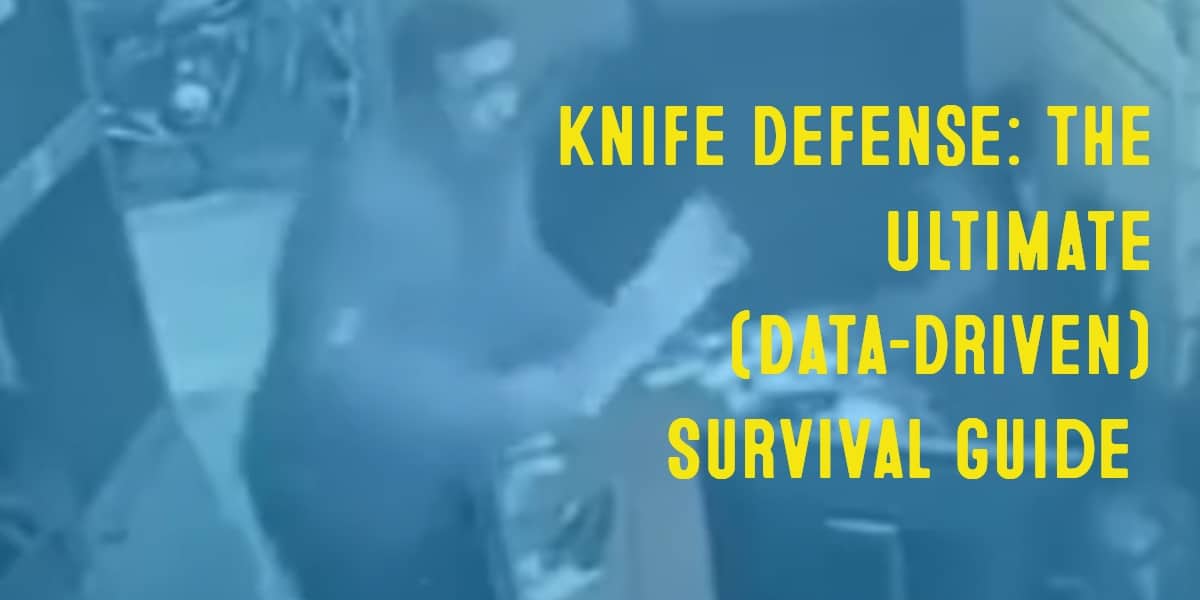

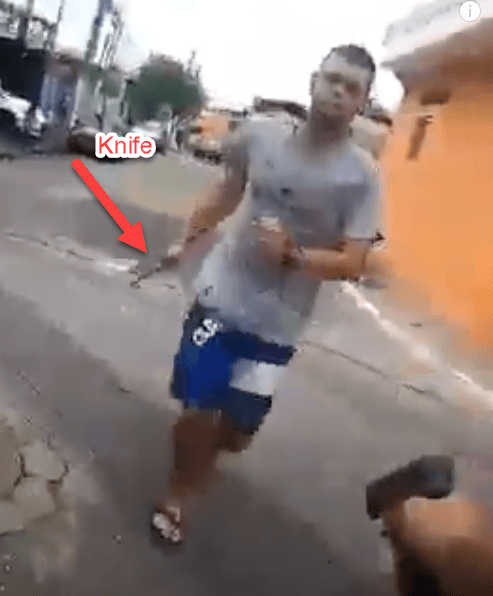

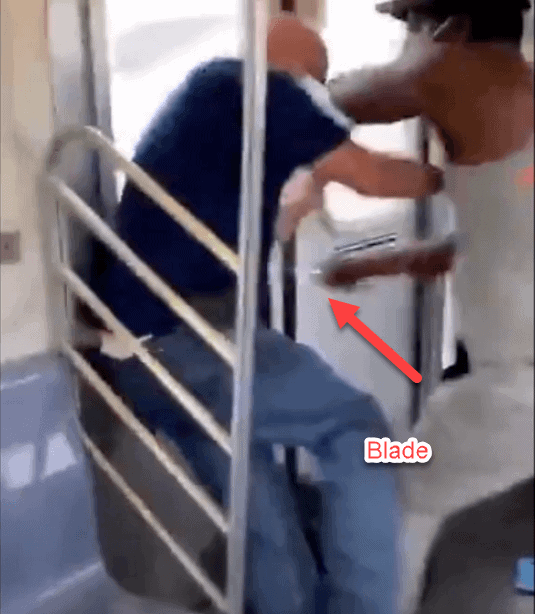
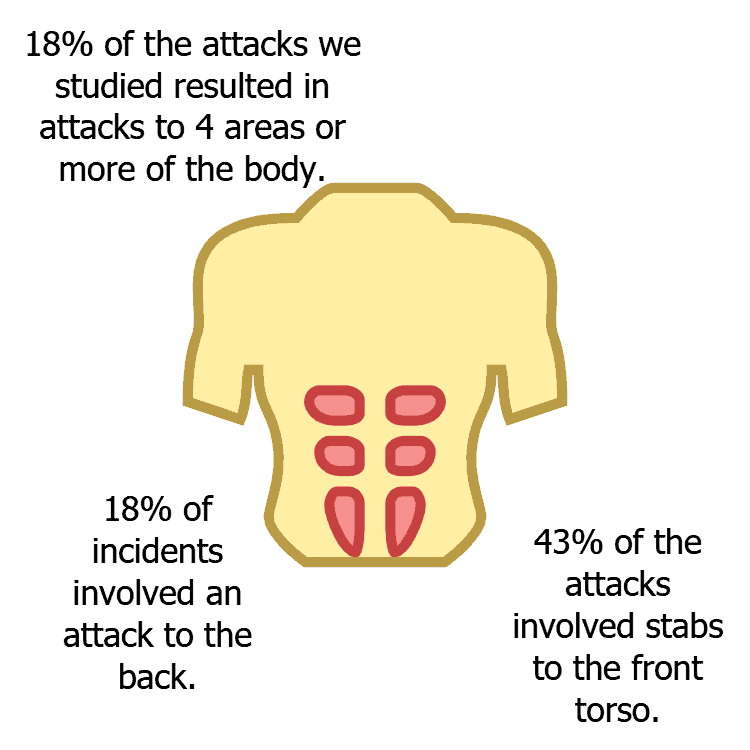


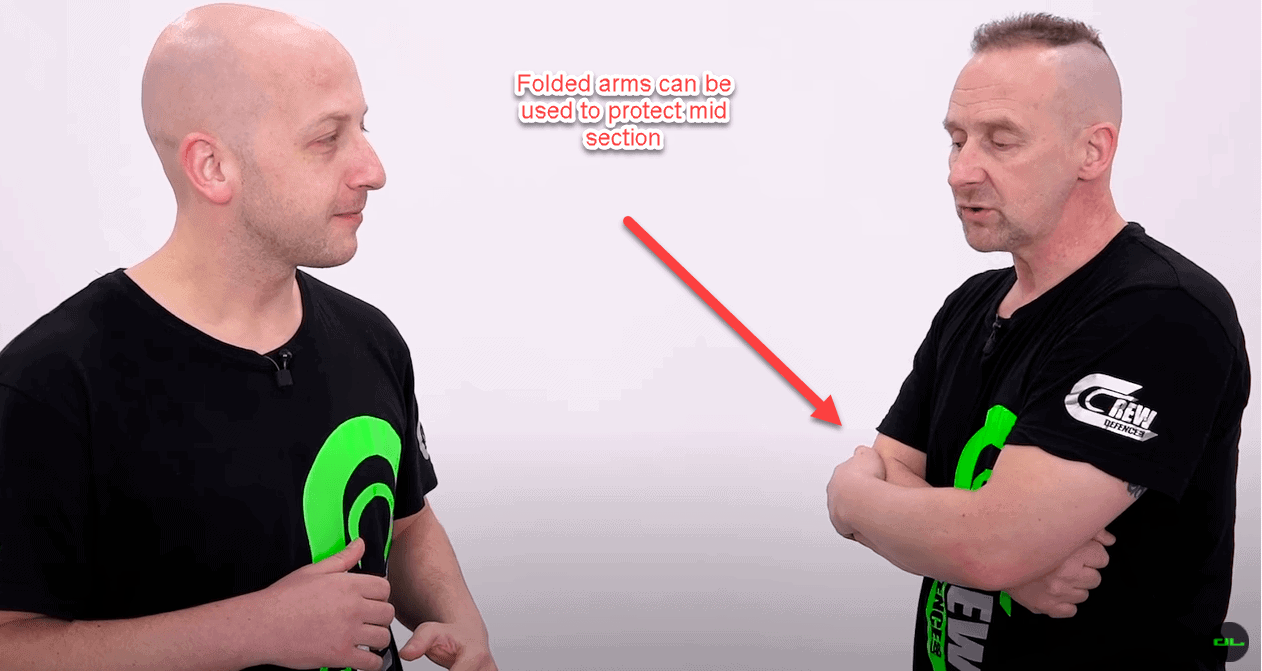

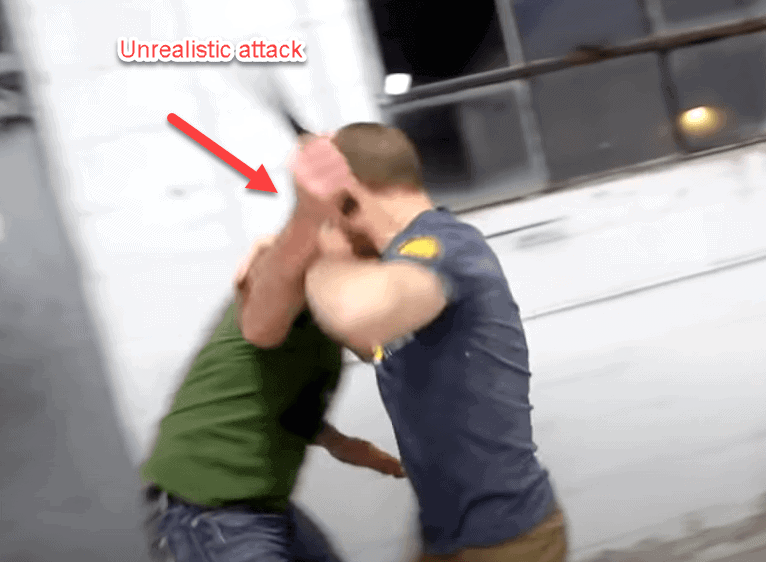

Solidly useful expansion on an excellent original article. Thank you.
Thanks Julian, glad you found it useful
I thought that the material on developing and training more appropriate defense strategies extremely good, especially attempting to analyze how to get a desirable outcome given that you’re probably injured before you even start.
However, this line seems to be a bit strange, at best:
“Of course, the survival rate will increase if your country has a range of good mental health support, strict sentencing for knife crime, and knife sales control.”
Good mental health support? Isn’t your mental health issue another man’s beliefs? If his income is determined by how many people he robs this week, do you think he’s going to be seeing a psychologist to help him find a job?
Strict sentencing for knife crime? I wonder how many young men you would have to jail to make a difference? I guess it would depend on how culture encourages or discourages this kind of behavior. If the law penalizes it, but culture does not, you’ve just got a perpetual problem.
Knife sales control? Seriously, is there anywhere in the world where a person can’t make a knife out of common building materials or eating utensils?
Hi, thanks for the comment. So, to break down what you say:
” Isn’t your mental health issue another man’s beliefs?”, no, mental health support, reduce mental illness within the community. Many mental illnesses involve a range of symptoms, of which some people are violent/ hear voices and are encouraged to do very awful things to vulnerable groups. There is already strong evidence to link poor mental health with knife crime. So, yes, good mental health support does reduce knife crime. This is totally different to robbery, which as the data suggest can easily be solved in most cases with victim compliance. Next up “I wonder how many young men you would have to jail to make a difference?” Strong sentencing is long been used as a deterrent for crime, as such, if people go away for longer then less young men or women will end up in prison. And finally,”Knife sales control? Seriously, is there anywhere in the world where a person can’t make a knife out of common building materials or eating utensils?”, Knives are the most accessible weapon on the planet, however being able to order weapons online, buy large knives from supermarkets and even martial arts weapons means that young people (of which knife crime is a particular problem) are easily able to access weapons. Knife control adds a layer of friction that helps to reduce ‘impulse’, ‘revenge’ and even ‘self protection’ use of edged weapons among younger people, mentally unwell and even criminals. All of the above are proven crime reduction strategies based on sound principles. Crime reduction is a very interesting topic, I highly recommend its study for anyone interested in self-protection and a better society.
A great and simple breakdown of how things can be made better across society, there!
There can always be debate about the actual usefulness of laws – not allowing “zombie knives” or “unlawful engraving” on a blade are too far, I feel, but 18yo plus sales limited to face to face with ID are fine.
Better mental health provision is always important. Too many in crisis are simply forced onto the street!
As for your article, it was very interesting. The stats are reassuring, at least!
Excellent survey and analysis Andrew!
Thanks Felix, glad you enjoyed it.
Thanks for that, very interesting information
Pleasure Paul